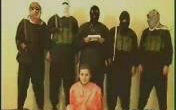
Terrorist Justifications for Kidnapping and Murder
In the latest news from Iraq , US military sources have discovered a torture center where severely beaten detainees were kept in dire conditions and found a manual on killing and kidnapping. The house was equipped with electric wires, a noose, handcuffs, and a 574 page book on jihad (holy struggle), written by Abdul Rahman al Ali. Its chapters included "How to Select the Best Hostage," and "The Legitimacy of Cutting the Infidels” Heads."
In a rare case of hostages rescued alive, four Iraqi men, who bore traces of torture were found by US troops. Some were close to death, such as Ahmad Isa Fadil, 19, who had been kidnapped from his family home because he was employed by the Iraqi military. He told his liberators of the daily assassinations that took place in the house and explained how he was waiting for his turn to die, after being severely beaten.
Entitled “The Principles of the Philosophy of Jihad”, the recovered manual and its author have intrigued many observers as they are no known extremist publication baring this title and no such author. Iraqi thinker Rasheed al Khayoon believes the author is probably hiding behind a nickname. Aliases are popular with many authors of militant manuals and pamphlets who refuse to reveal their true identities, unless they are far from the reach of the security forces, such as Ayman al Zawahiri, Osama bin Laden’s right hand man. In other instances, writers calling for military action have been exposed after being arrest by the authorities, for example, Faris Shuail al Zahrani, a Saudi citizen who used the nickname “Abu Jandal al Azadi” to write a book “The Motives to Kill Security Officers”. A member of the Legal committee of al Qaeda in the Kingdom, he was caught in the South of the country.
Militant Islamist groups active in Iraq are known to have carried out kidnappings as part of their violent actions which they justify by appealing to religion. In its issue 66, the fundamentalist journal “Al Mujahedun” published the writings of Abu Mohammed al Maqdisi, the mentor of the leading figure in the Iraqi insurgency, Jordanian Abu Musab al Zarqawi.
The article examined the purpose and legitimacy of violence and hostage taking. It included practical advice on how to pull off a successful kidnapping by dividing the group into three: a planner, an executioner, and an observer. Accordingly, the person entrusted with hostage taking ought to be: physically fit, a good shooter, ready for martyrdom, courageous, sincere, secretive, quick to react, accurate, and tactically aware. As for the observer, he should be able to store large amounts of information, correctly estimate the strength of police officers, and know the climate and typography of the area. The articles added that” the detention of hostages or their release is a complicate operation that requires swift and decisive action.”
It is worth mentioning that the manual, found in the town of Karabila also features a whole chapter on the legitimacy of beheading hostages. It seems insurgents in Iraq are keen on using swords to kill their victims because, according to an informed source, the method is both closer to tradition and terrifying. The “Tawhid and Jihad” group, headed by Abu Mohammed al Maqdisi, posted a fatwa (religious edict) on its website stating that killing by beheading is preferable and legitimate, based on an old edict by the jurist Ibn Abd al Badr, who died in the 11th century.
The town of Karabila lies close to thecity of al Qaim, next to the border with Syria . The area has witnessed fierce battles between Iraqi and US forces and the insurgents. Originally, the name refers to a clan from the Aqidat tribe which populates this region of Iraq .
